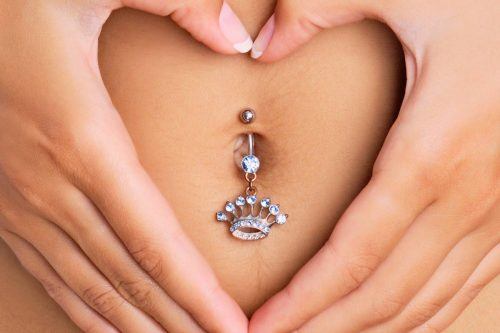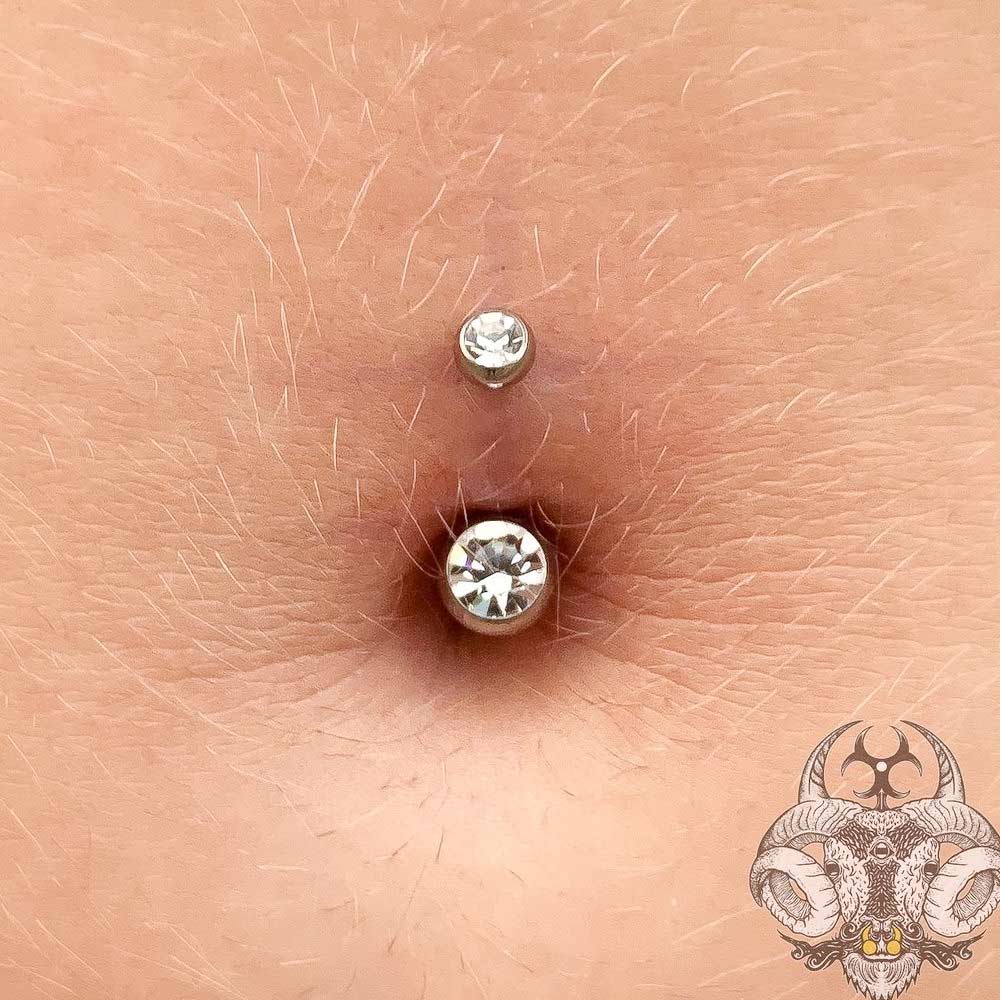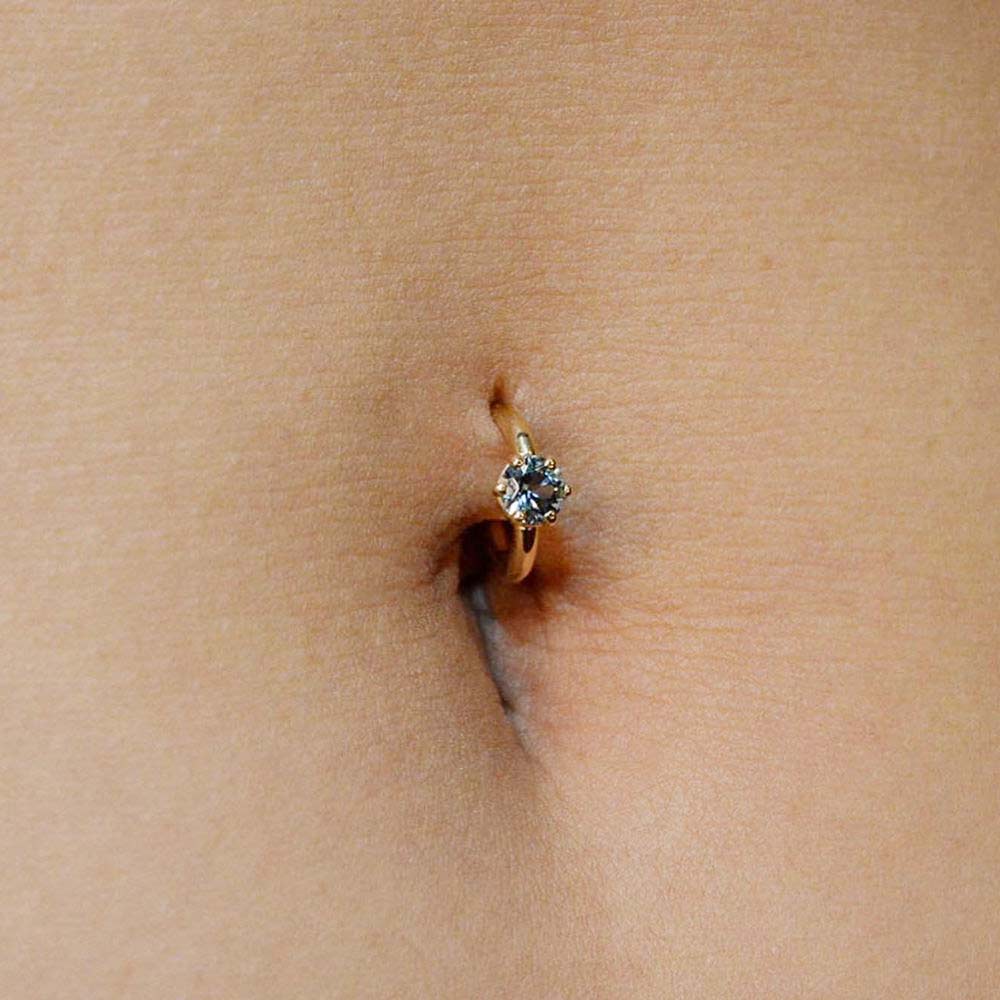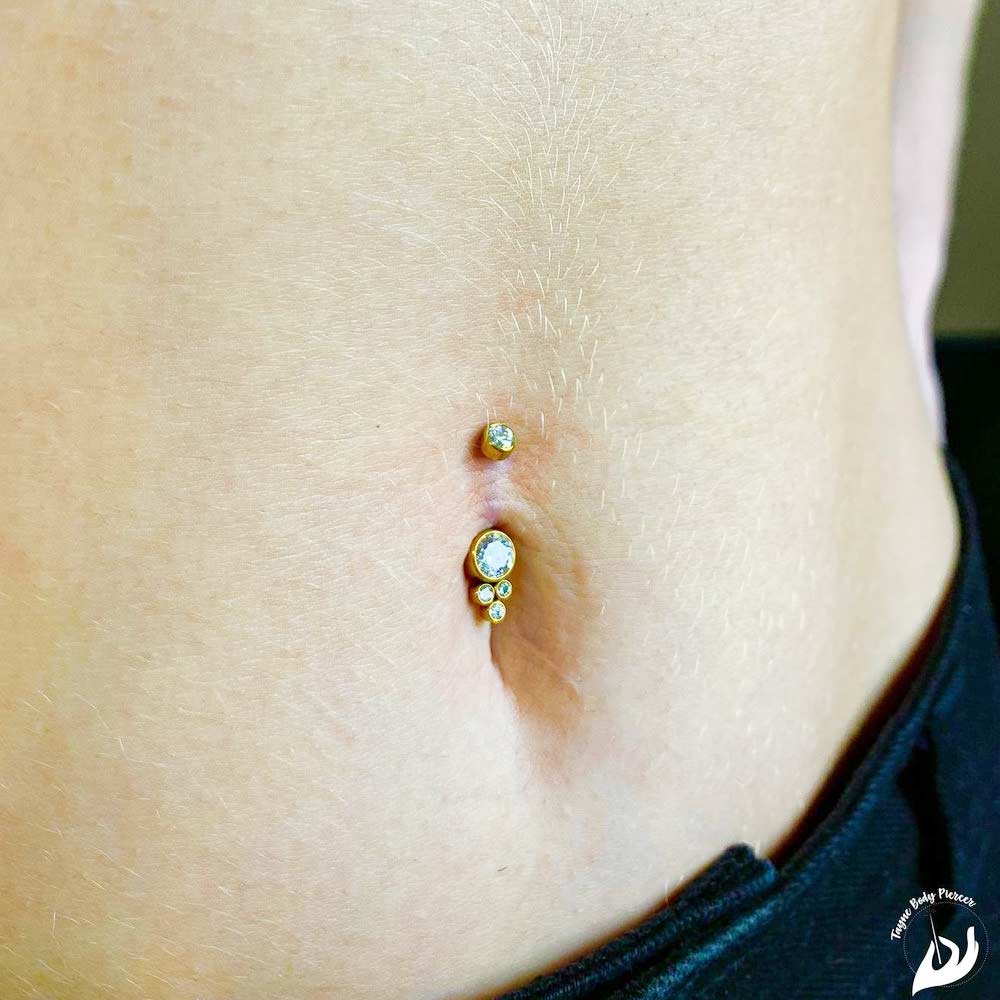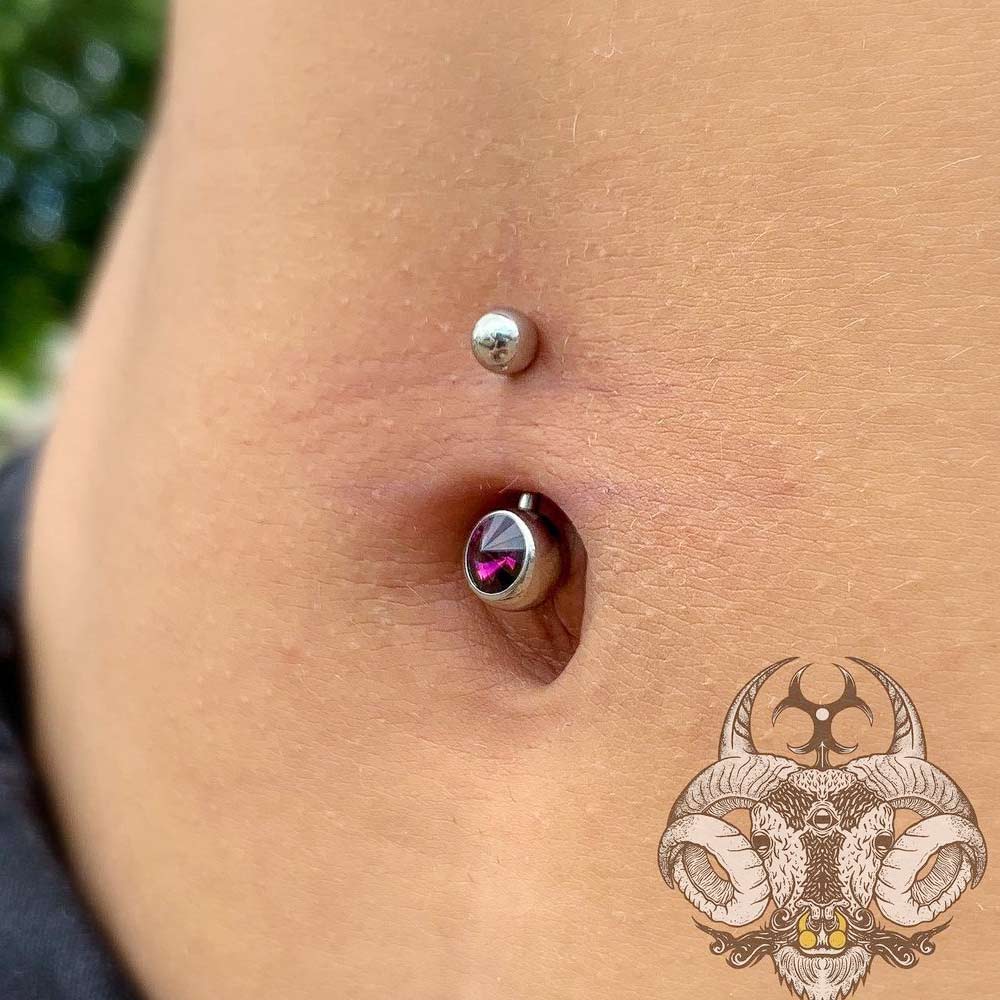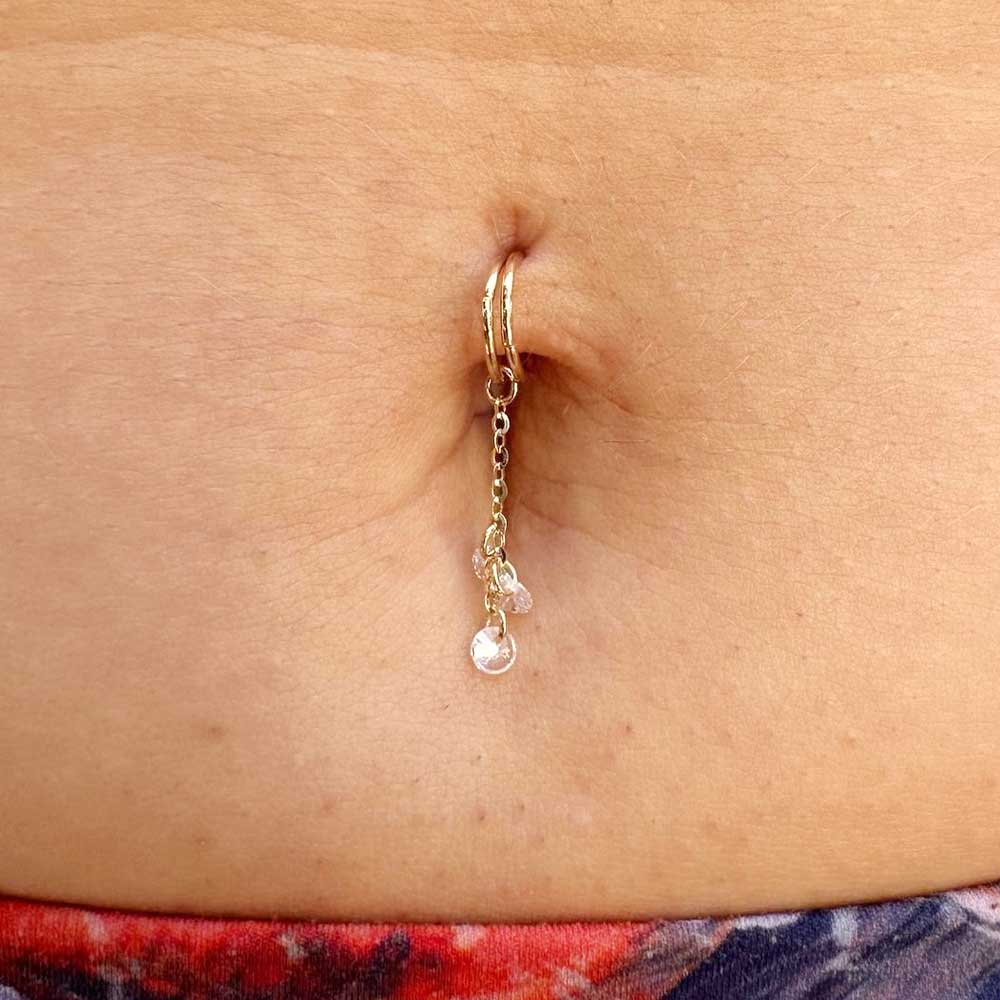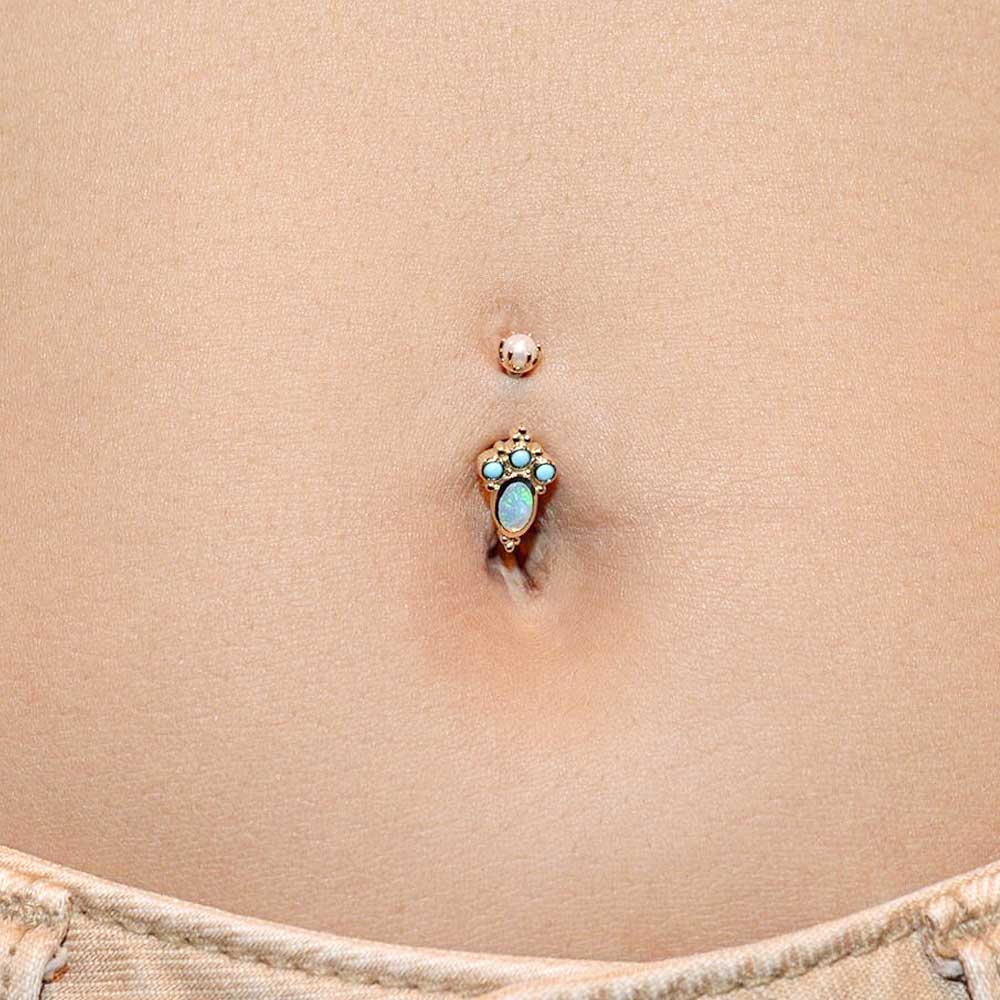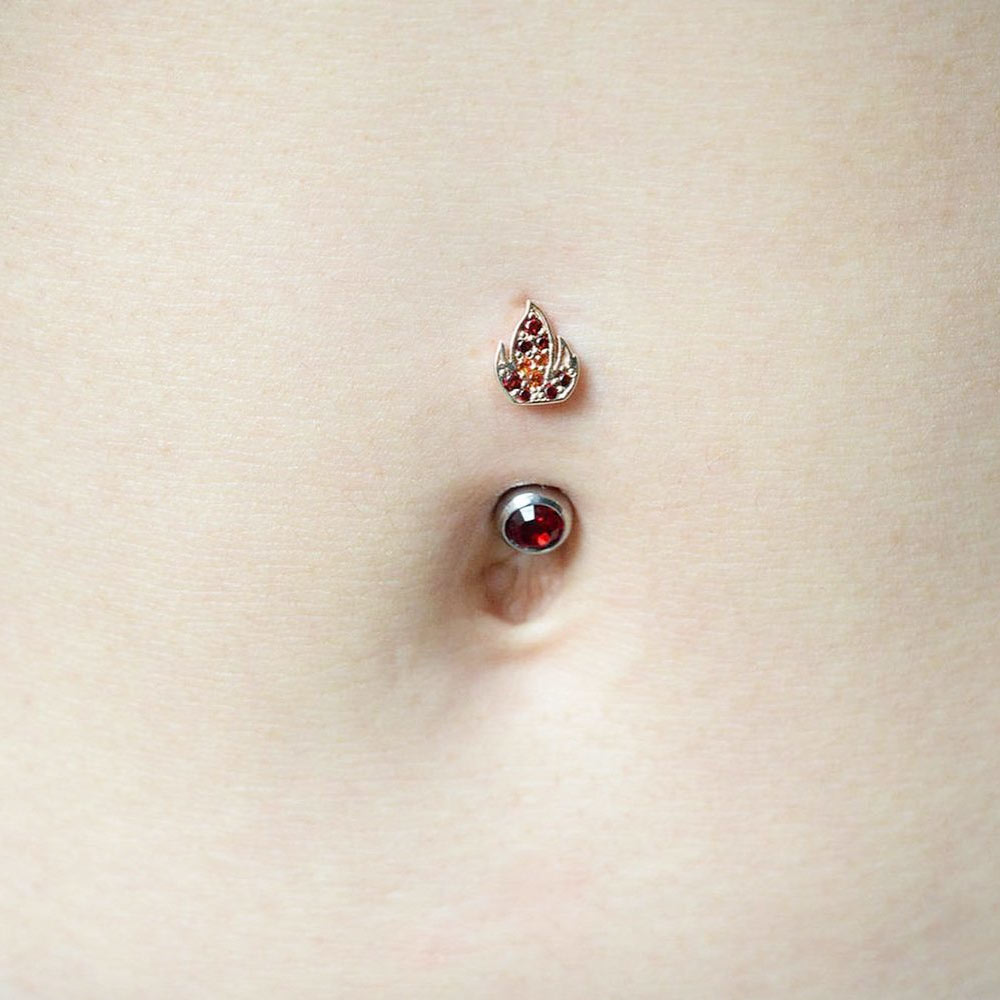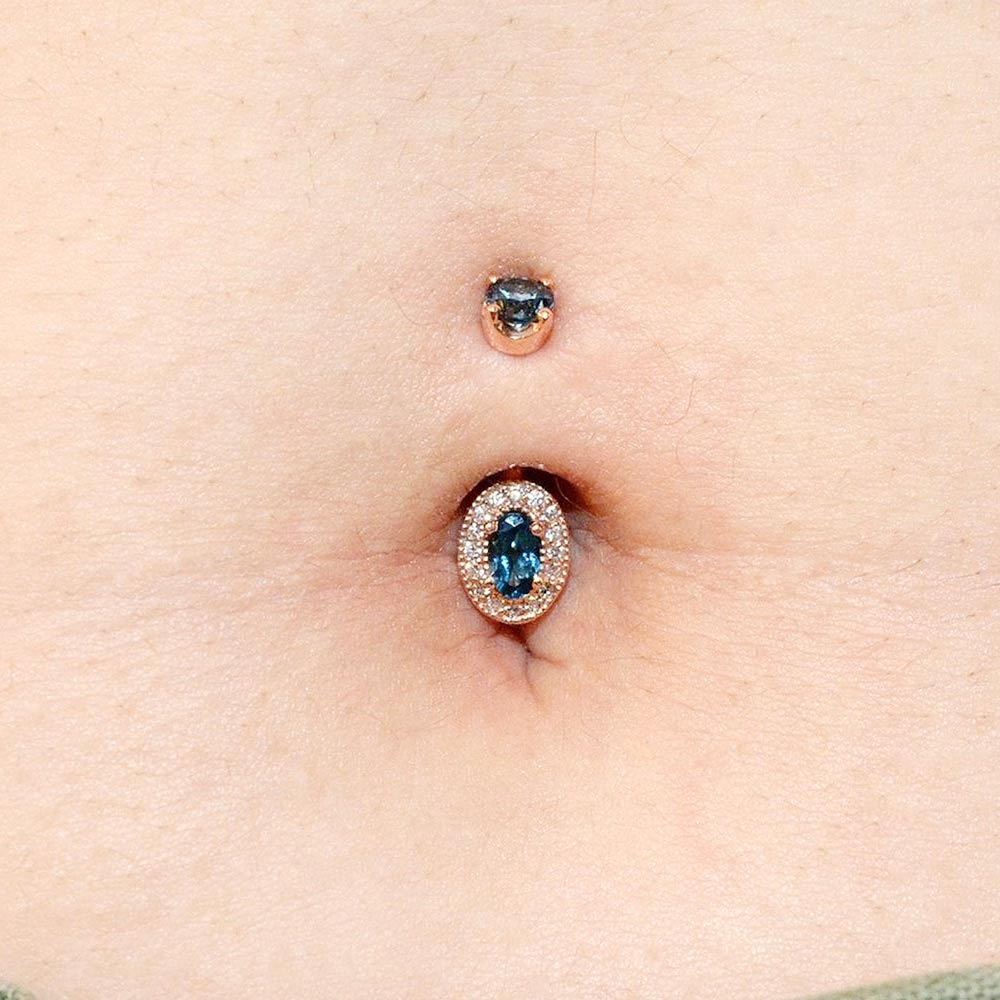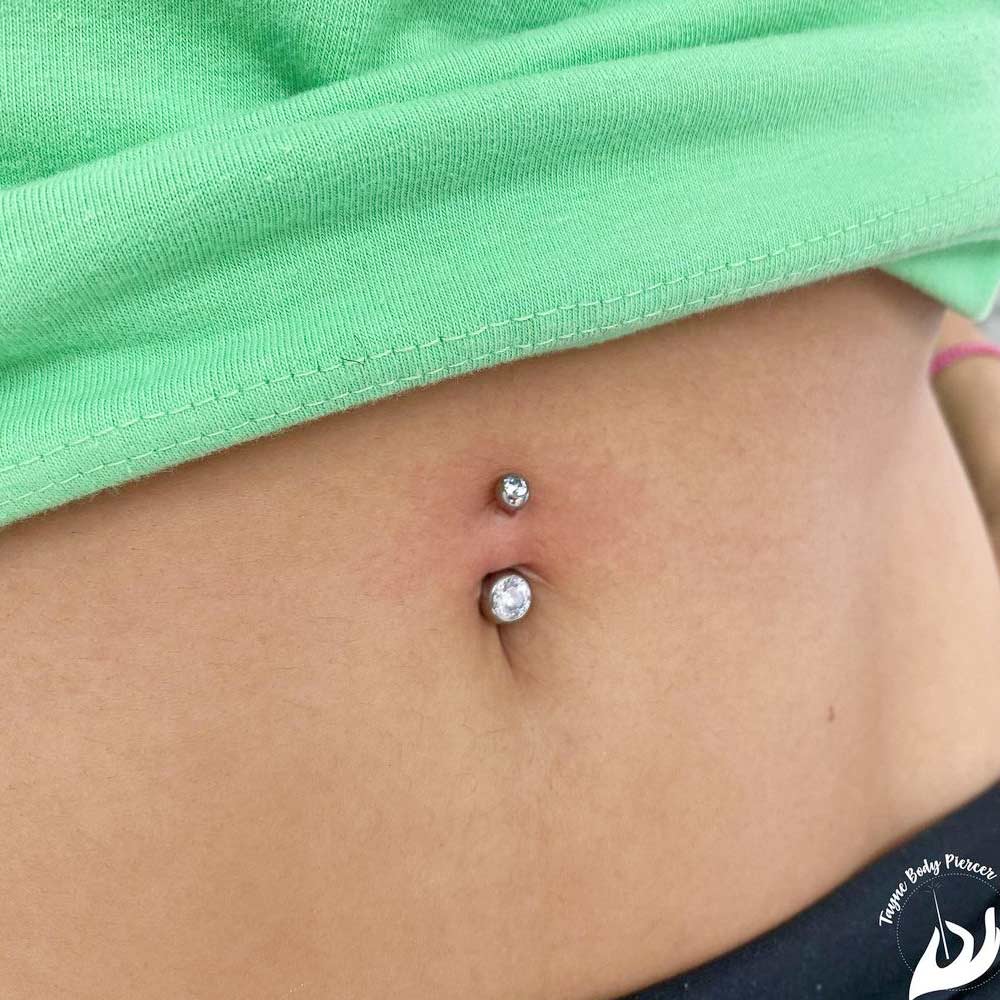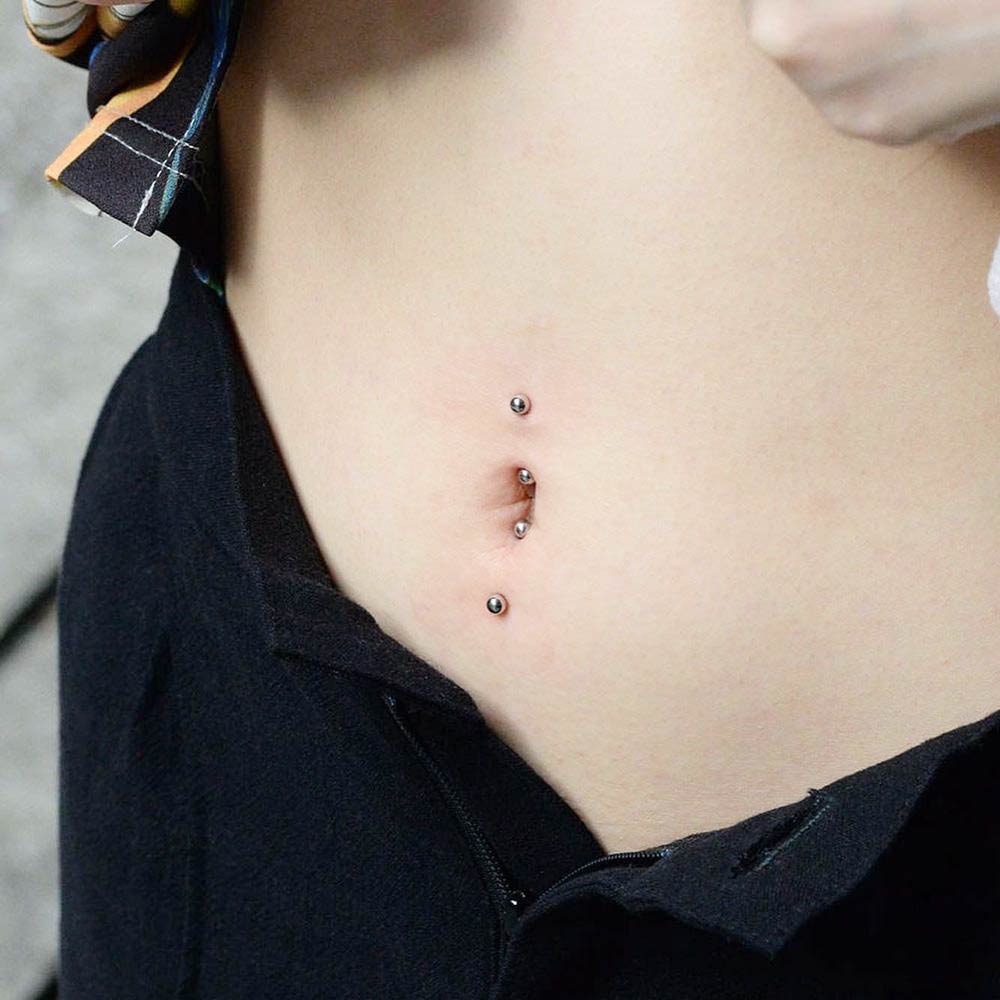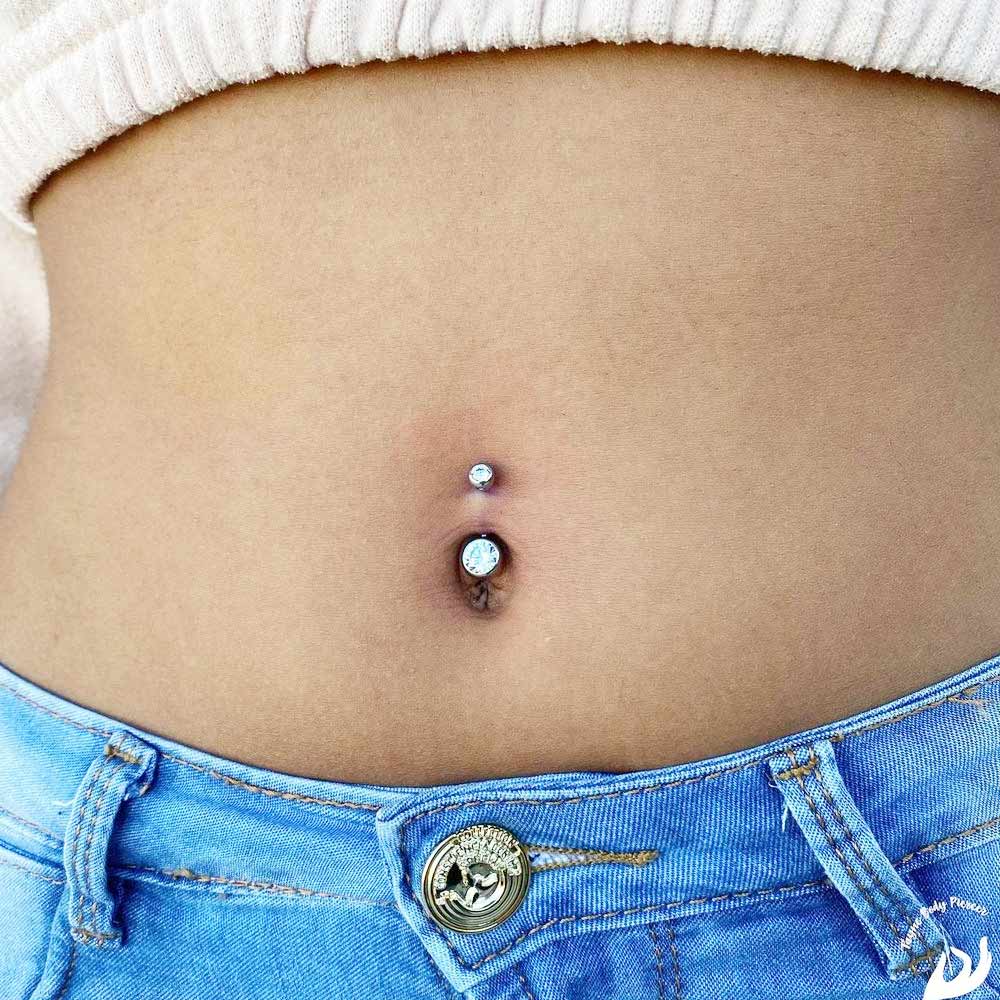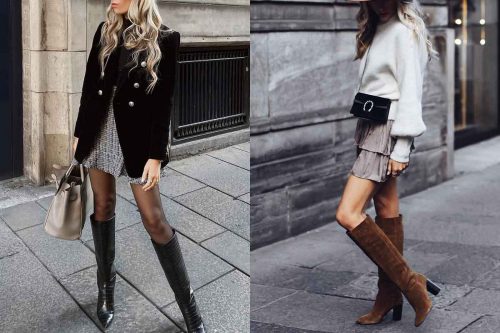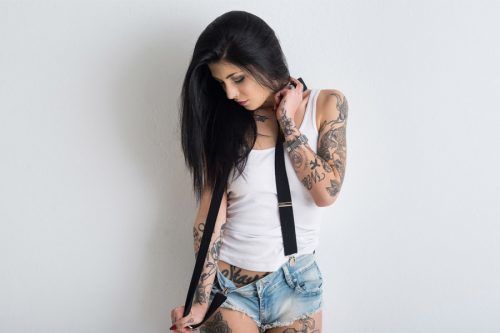The belly button piercing belongs to those body piercing types that are always on trend. It is versatile, relatively easy to get and can be hidden under your clothes whenever needed. What else could you ask for from a moderately painful piercing? If you do not have your belly button pierced yet, something tells us that after studying our guide, you will immediately book an appointment with your piercer. So, wait no longer to adorn your body with the timeless navel piercing.
What is a Belly Button Piercing?
by @robpiercerA belly button piercing, which is also often called a navel piercing, is a body piercing that implies getting a fold of skin above your belly button punctured and threading jewelry through it. The jewelry usually covers the belly button a little, which makes it stand out. You can get this piercing style in several ways. Thus, there is a single and double piercing of belly button, for which the skin is also pierced below the belly button, as well as horizontal and vertical piercings. As you can tell, none of them suggest puncturing your stomach. So, if you were worried about this, you should no longer be. One of the main benefits of navel piercings is that they hurt less than other types, which is due to the fact that the skin on the surface has fewer nerve endings.
How is a Belly Button Piercing Done?
by @gate_bridgeThere are options for how you can get your belly button piercing done – either pierced with the help of tools or freehand. The whole process will look like this:
- First, the piercer will clean the area around your belly button.
- In case you have hair in the area, the professional will shave it to have clean and unobstructed access.
- The ‘tool’ method implies that the clam will be used to hold the area.
- Then, the piercing markings are added.
- It is a good idea to check the markings to ensure that the piercing will be placed right where you want it.
- If everything is correct, the professional will use a hollow needle to pierce the skin and then insert the chosen jewelry.
- There may be some bleeding after the needle is out, but there’s nothing to worry about.
- The healing process involves tenderness, slight swelling, and redness, but it will pass quickly.
The Best Jewelry Materials for Belly Button Piercings
by @taynepiercerYou will usually be offered three main types of material to go with your belly button piercing. They are the following:
- Implant-grade stainless steel – is one of the most common and the safest metals for body piercings. The metal is known to be low-irritant and non-allergic.
- Titanium – people allergic to nickel often choose titanium piercing jewelry.
- Gold – some people prefer gold jewelry due to the sheer aesthetical appeal of the metal. However, gold may trigger allergic reactions, and it is best to check whether you are allergic to gold. Keep in mind that gold lower than 14 karats is too soft for the purpose and may interfere with the healing process.
Belly Button Piercing Jewelry
As such, the belly button piercing allows for a wide variety of jewelry options. The most popular are:
- Belly bars. Belly piercing bars are essentially curved barbells. There are tons of different curved barbells for the navel piercing. They come in various materials, styles and with different adornments. So, it is not that hard to find a suitable piece of belly button jewelry for everyone.
- Belly button rings. Rings for the belly piercing may be dangle and non dangle, regular and reverse. All of them can be found in different materials and designs, inlaid or plain. What makes dangling rings differ from non dangling is that the former also feature charms, which are moving along with you. Reverse belly rings, in their turn, are inserted so that the charm is hanging above your navel. Another popular type of jewelry for belly button piercings is a captive bead ring, which creates a low key yet stylish appearance.
Those who are only considering the navel piercing can try it on with the help of the fake belly button piercing. The choice of jewelry is rather limited compared to the real piercing, yet, it is more than enough to get the idea whether you like it or not.
Important note: it's best to avoid swimming in pools, hot tubs, lakes, or oceans for at least the first few months to prevent infection. Always ensure the piercing is fully healed before submerging in water.
How Much Does a Belly Button Piercing Cost?
by @taynepiercerWhile the belly button piercing price is not the determining factor, it should not be overlooked too. So, how much does a piercing for belly button cost? On average, you may be charged anywhere between $25 and $70 for the work itself. The jewelry for belly button piercing cost starts from $15. Yet, the final price may vary, depending on the location of the parlor, the professionalism of the piercing artist, etc. Also, you should not forget about the tip, which is usually from 5% to 15% of the final cost.
Important note: people with "outie" belly buttons can still get piercings, but the placement and technique might differ. Consult with a professional piercer to discuss your options.
Stuff You Should Know Before Getting A Belly Button Pierced
by @gate_bridgePain. This is arguably one of the best things about this piercing type – it is not particularly painful, at least compared to other body piercing types. Because it only engages your skin above the belly button, where the number of nerve endings is moderate, it will feel more like a pinch.
Healing. When it comes to healing belly button is not one of the fastest to heal, however, not one of the longest either. The belly button piercing healing period is affected by the proper aftercare and your daily routine. With that in mind, how long does a belly button piercing take to heal? On average, it may take around 6-12 months to be completely healed.
Aftercare. Taking care of your belly piercing properly guarantees that it will heal fast and with few to no side effects. So, make sure to clean the pierced spot regularly and thoroughly. Not sure how to clean belly button piercing? Apply a saline solution to it in the morning and in the evening and pat it dry using a paper towel. Do not forget that your hands should be clean as well when you touch the piercing. Also, to aid the process, do not wear tight clothes and especially waistbands, as they can make the wound worse.
Side effects. The most common side effects of getting your belly button pierced are rash, discharge and infection. When the pierced spot becomes irritated for some reason, there may be rash around it. Also, you may notice that the piercing is oozing with some fluid. If it is off white and present only at the beginning of the healing process, then there is nothing to worry about. Though in case the discharge continues to appear and it is yellow or another color, then this is a signal that you need to visit a doctor. Although the belly button piercing infection is one of the most serious side effects, it is also one of the most common. There are plenty of reasons why it may occur, from bad aftercare to an individual body reaction. No matter what caused it, yet again, you should not postpone the visit to the doctor.
How To Clean Your Belly Button
by @nameIt takes time for any body piercing to heal fully, and a belly button piercing isn’t an exception. A few days after the procedure, you may see some white fluid coming from the holes, but it’s normal. Yet, you should keep the area clean and well-cared for to ensure that it heals fast and well.
- Always wash your hands with soap before you start cleaning the piercing site with warm water.
- Never pick on the crust that may form around the piercing.
- You can clean the area with soap, too. Leave a small amount of soft soap on the area for about 30 seconds and rinse it off well.
- Clean the area with a sterile saline solution.
- Repeat the process 5-10 times a day.
- Don’t leave the area wet. Pat it dry with a clean towel of paper towels.
As you can tell, getting the belly button piercing is not that difficult provided you know what to expect from it and how to look after the wound. The stylish touch it adds to your appearance though is undoubtedly worth your time and effort. We hope the guide we prepared for you has shed enough light on the topic so that you have no more questions or doubts left.
FAQ: Piercing for Belly Button
What belly buttons cannot be pierced?
Not all belly buttons are suitable for piercing. If yours is protruding too much or there is no fold of skin above the belly button, then you may be either offered the inverse navel piercing or denied one at all.
What should I wear after getting my belly button pierced?
Go for loose and comfy clothes after you have got your belly piercing. You can put on shorts or trousers, yet, make sure they do not press on your new piercing. The pierced spot should remain accessible.
Can you shower right after getting your belly button pierced?
Showers with soap and rubbing should be postponed after the piercing has healed. Until then, you may only rinse your body with lukewarm water and clean the pierced area with a saline solution.
Do belly button piercings bleed?
Navel piercing bleeding may take place if you pick at the crust formed around the wound. So, keep your hands away from it until it comes off naturally. Off white discharge though is considered a variant of the norm.
Was this article helpful?



